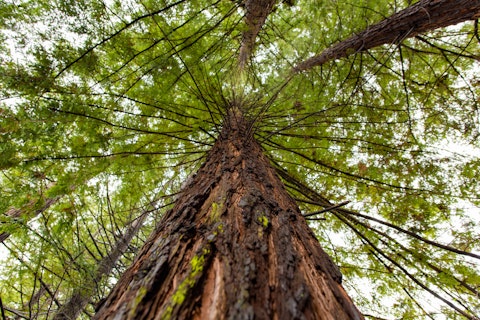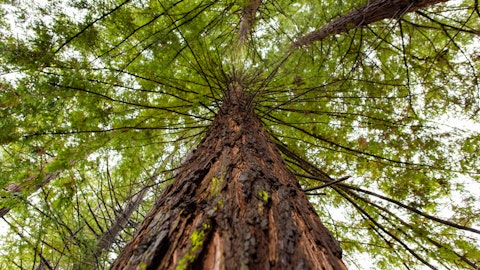In this piece, we will take a look at the 25 least forested countries in Europe. If you want to skip our introduction to the forestry industry and recent events, then check out 5 Least Forested Countries in Europe.
The fundamental factor behind humanity’s progress from cave dwellers to the modern day society is the ability to manipulate matter. Some of the most crucial inventions or discoveries that ensured humans would be able to survive the harsh environment of the Stone Age included inventing the wheel and discovering fire. These two enabled humans to transport large loads, warm themselves, and ensure that food was free of pathogens – crucial developments at a time when a handful of humans roamed the Earth instead of the billions that inhabit it today.
Another key material that has played a crucial role in modernization is wood. When compared to stone or iron, wood is easier to manipulate and it is readily available in the form of houses. The world’s earliest carriages, dwellings, and kitchens all used wood for either walls, frames, or cooking, and before the invention of the internal combustion engine, wood and coal fired steam engines were at the heart of early advances in transportation.
However, just like the consequences of burning fossil fuels have led to damage to the environment, the cost of relying on forests for wood has also made its impact. This impact is in the form of reducing forest coverage, with data from the United Nations Food and Agriculture Organization (FAO) indicating that between the decade that passed between 1990 and 2000, global forest area dropped by 7.8 million hectares on an annual basis. This has led to a whopping 420 million hectares of forests dropping between 1990 and the present day. For reference, the United States covers an area of 166 million hectares. Canada, the world’s second largest country in terms of area, measures 362 million hectares, so not only has deforestation removed more forests than the area of the U.S. over the past three decades or so, but also more than the area of the second largest country in the world.
Moving towards the business side of things, research suggests that the global forest industry was worth $981 billion in 2022 and is slated to be worth $1 trillion by the end of 2023. From 2023 to 2027, the industry is expected to grow at a compounded annual growth rate (CAGR) of 10.2% to have a value of $1.6 trillion by the end of the forecast period. Like other industries, the forestry industry is also making use of advances in computer technology, as research also shows that the forestry software market was worth $1.25 in 2021 and is expected to grow at twice the CAGR of the broader forestry industry at 22.4% to be worth $6.3 billion in 2029.
When it comes to wood consumption, statistics match those for coal consumption. Like coal, China is also the world’s largest global consumer of wood. Data from the FAO shows that China consumed roughly 25% of sawn wood in 2020, but unlike coal, the second heaviest user of sawn wood is the U.S. When it comes to wood production, China also produced the most wood in the world, as it accounted for 18% of the total supply. The U.S. and Russia followed China in second and third places, respectively. Like other commodities, wood and lumber also has a global market and its prices fluctuate in response to events and supply chain constraints. And as was the case with some other commodities, lumber prices also soared last year in the aftermath of the Russian invasion of Ukraine which saw lumber prices soar to $1,465 per 1,000 feet or $1.4 per foot in February 2022.
As the market adjusted, prices came down later but in 2023 lumber prices are starting to rise once again. The lumber market faced a bit of strain earlier this year due to shocking and devastating wildfires that plagued Canada and the United States earlier this year. This was because 9.2 million hectares of forest were burned during Canada’s fires, and if you’ve been reading carefully so far, then more forests were burnt in Canada during the catastrophe than were lost per year between 1990 and 2000. Another key determinant of lumber prices is construction activity since more homes built spur the demand for food and force suppliers to expand their supply which causes a price increase.
If you’re interested in investing in the lumber industry, then we’ve also made a list of the 15 Biggest Lumber Companies in the World which ranks the firms based on their annual softwood production in 2021. The three biggest lumber companies in this list are West Fraser Timber Co. Ltd. (NYSE:WFG), Canfor Corporation (OTC:CFPZF), and Weyerhaeuser Company (NYSE:WY).
With these details in mind, let’s take a look at the least forested countries in Europe.

mark smith nsb/Shutterstock.com
Our Methodology ‘
To compile our list of the least forested countries in Europe, we used data from the FAO’s Global Forest Resources Assessment (FRA) published in 2020. This report is published every five years, and it covers the forest cover of all countries in the world.
25 Least Forested Countries in Europe
25. Portuguese Republic
Forest Cover in (‘000) Hectares: 3,312
Portugal is a Southwestern European nation with high levels of human development. It has a $267 billion economy, and low forest levels can somewhat be attributed to the paper industry in its rural areas.
24. United Kingdom of Great Britain and Northern Ireland
Forest Cover in (‘000) Hectares: 3,190
The U.K. boasts one of the largest economies in the world, but one that has struggled since the coronavirus pandemic. Due to its small land mass, even though the U.K. has lower forest cover compared to other countries, it covers roughly 12% of its area.
23. Georgia
Forest Cover in (‘000) Hectares: 2,822
Georgia is an Eastern European nation that is one of the smallest countries in the continent in terms of area. It has experienced rapid deforestation over the past couple of decades due to economic activities.
22. Republic of Serbia
Forest Cover in (‘000) Hectares: 2,723
Serbia is a Central European country with hundreds of environmentally protected areas. Its forest ownership is roughly equally divided between the public and private sectors.
21. Czech Republic
Forest Cover in (‘000) Hectares: 2,677
The Czech Republic is a landlocked Central European country with a $330 billion economy and high levels of human development.
20. Republic of Estonia
Forest Cover in (‘000) Hectares: 2,438
Estonia is a Northern European country located close to Russia and Finland. It is one of the most bio diverse nations in the world and forests cover nearly half of Estonia.
19. Republic of Lithuania
Forest Cover in (‘000) Hectares: 2,201
Lithuania is a Baltic European nation. It has a $78 billion economy and it relies heavily on its forests for industrial production and output.
18. Bosnia and Herzegovina
Forest Cover in (‘000) Hectares: 2,188
Bosnia and Herzegovina is a Southeastern European country. It has four major forest regions, and close to half of the country’s area is covered by forests.
17. Hungary
Forest Cover in (‘000) Hectares: 2,053
Hungary is a Central European country with a $188 billion economy and high levels of human development. It shares its forest ecosystem with several countries including Ukraine, Austria, Romania, and Bosnia and Herzegovina.
16. Republic of Croatia
Forest Cover in (‘000) Hectares: 1,939
Croatia is a Central and Southeastern European country which is one of the most developed nations in the world. It has a $78 billion economy.
15. Slovak Republic
Forest Cover in (‘000) Hectares: 1,926
Slovakia is a landlocked Central European country. It has high levels of human development and a $127 billion economy. Forests cover more than 40% of its area.
14. Swiss Confederation
Forest Cover in (‘000) Hectares: 1,269
Switzerland is a prosperous country with a well developed banking and finance industry. The country has one of the highest GDP per capita in the world, but this is accompanied by equally high living costs.
13. Republic of Slovenia
Forest Cover in (‘000) Hectares: 1,238
Slovenia is one of the smallest countries in the world in terms of both its population and area. It has a small $68 billion economy but a high GDP per capita of $32,214.
12. Montenegro
Forest Cover in (‘000) Hectares: 827
Montenegro is a Southeastern European nation that covers an area of 13,812 square kilometers. It is one of the most bio diverse countries in Europe which features several different kinds of forests.
11. Republic of Albania
Forest Cover in (‘000) Hectares: 789
Albania is a relatively poor country by European standards since it has a GDP per capita of $6,369. It has thousands of different kinds of plant species and forests are located in the mountainous regions of the country.
10. Republic of Ireland
Forest Cover in (‘000) Hectares: 782
Ireland is a developed European country that covers the island of Ireland. Natural causes and clearing for agriculture are some of the reasons that its forest cover has dropped over the years.
9. Kingdom of Belgium
Forest Cover in (‘000) Hectares: 689
Belgium is one of the most developed countries in the world. It has a $624 billion economy and a GDP per capita of $53,377.
8. Denmark
Forest Cover in (‘000) Hectares: 628
Denmark is a Nordic European country that has one of the poorest records in Europe when it comes to preserving its forests as large areas have been transformed into land for agricultural use.
7. Republic of Moldova
Forest Cover in (‘000) Hectares: 387
Moldova is a landlocked Eastern European country. Forests cover a small percentage of its area and are full of different kinds of animals.
6. Netherlands
Forest Cover in (‘000) Hectares: 370
The Netherlands is a developed country with a $1 trillion economy. It has lost most of its original forests and the ones present right now are non native species. Netherlands’ original forests belonged to the Western European Atlantic mixed forests. These included a variety of animals such as different species of deer and bears.
Click here to continue reading and check out 5 Least Forested Countries in Europe.
Suggested articles:
- 25 Most Gender and Income Equal Countries in the World
- 29 Best Alcoholic Drinks that Don’t Taste Like Alcohol
- Top 20 Countries With Most Natural Resources in the World
Disclosure: None. 25 Least Forested Countries in Europe is originally published on Insider Monkey.



